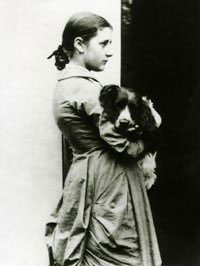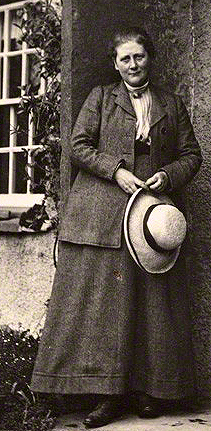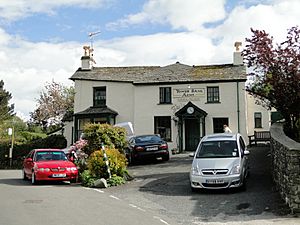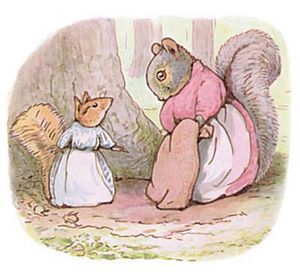Beatrix Potter facts for kids
Helen Beatrix Potter (28 July 1866 – 22 December 1943) was an English writer, illustrator, mycologist and conservationist. She is most famous for writing and illustrating wonderful children's books about animals, like The Tale of Peter Rabbit. Her books are loved by children all around the world.
Potter wrote about 30 books; the best known being her 24 children's tales. Potter's books continue to sell throughout the world in many languages with her stories being retold in song, film, ballet, and animation, and her life depicted in a feature film and television film.
Contents
Early life

Beatrix Potter was born into a wealthy family in London, England. Her parents, Rupert William Potter (1832–1914) and Helen Potter (née Leech (1839–1932)), were artistic and enjoyed spending time in the countryside. Rupert practised law and the family lived comfortably at 2 Bolton Gardens, West Brompton. Beatrix and her younger brother, Bertram, were mostly educated at home by governesses, the last of whom was Annie Moore (née Carter). She and Beatrix remained friends throughout their lives and Annie's eight children were the recipients of many of Potter's delightful picture letters. It was Annie who later suggested that these letters might make good children's books.
Their home in London had a schoolroom where Beatrix and Bertram kept a variety of pets! They had mice, rabbits (including one named Peter, who was a big inspiration!), a hedgehog, bats, and even collections of insects. They would spend hours watching these animals very closely and drawing them. This careful observation helped Beatrix become an amazing artist who could capture the personalities and movements of animals so well in her drawings.
The family also took long holidays away from the city, often to Scotland and later to the beautiful Lake District in northwest England. These trips were very important for Beatrix. In the countryside, she had the freedom to explore nature, something she loved very much. She would spend her time sketching and painting the plants, flowers, landscapes, and animals she saw. These holidays helped her develop a deep love for the natural world that would stay with her throughout her life.
Beatrix was encouraged to draw from a young age and kept sketchbooks from when she was just eight years old. She learned by practicing a lot, drawing things she saw in nature, and copying illustrations. She later said that she was glad her education wasn't too strict or formal, as she felt it allowed her to keep her own unique way of seeing and drawing things.
Scientific illustrations and work in mycology
Besides her artistic talents, Beatrix Potter was also very interested in science. She studied plants and animals and learned how to draw what she saw even through a microscope. She was curious about many areas of nature, including archaeology (studying old things from the past) and entomology (studying insects).
However, her biggest scientific passion was mycology, which is the study of fungi. She was fascinated by their different colors and how they seemed to appear and disappear quickly in nature. She spent a lot of time collecting and drawing fungi, making very detailed and accurate scientific illustrations. Her interest deepened after meeting Charles McIntosh, a revered naturalist and amateur mycologist, during a summer holiday in Dunkeld in Perthshire in 1892. He helped improve the accuracy of her illustrations, taught her taxonomy, and supplied her with live specimens to paint during the winter. Curious as to how fungi reproduced, Potter began microscopic drawings of fungus spores (the agarics) and in 1895 developed a theory about how fungi spores reproduce. In 1897, Beatrix wrote a paper about her findings and included her detailed drawings. It has only recently been rediscovered, along with the rich, artistic illustrations and drawings that accompanied it.
Potter's scientific drawings are still admired today for their accuracy, and mycologists still refer to them to identify fungi.
Artistic and literary career
Potter studied book illustration from a young age and developed her own tastes. Works of Walter Crane, Kate Greenaway and Randolph Caldecott had a great influence on her. When she started to illustrate, she chose first the traditional rhymes and stories, "Cinderella", "Sleeping Beauty", "Ali Baba and the Forty Thieves", "Puss-in-boots", and "Red Riding Hood". But most often her illustrations were fantasies featuring her own pets: mice, rabbits, kittens, and guinea pigs.
As a way to earn money in the 1890s, Beatrix and her brother began to print Christmas cards of their own design, as well as cards for special occasions. Mice and rabbits were the most frequent subject of her fantasy paintings. In 1890, the firm of Hildesheimer and Faulkner bought several of her drawings of her rabbit Benjamin Bunny to illustrate verses by Frederic Weatherly titled A Happy Pair. In 1893, the same printer bought several more drawings for Weatherly's Our Dear Relations, another book of rhymes, and the following year Potter sold a series of frog illustrations and verses for Changing Pictures, a popular annual offered by the art publisher Ernest Nister. Potter was pleased by this success and determined to publish her own illustrated stories.
Whenever Potter went on holiday to the Lake District or Scotland, she sent letters to young friends, illustrating them with quick sketches. Many of these letters were written to the children of her former governess Annie Carter Moore, particularly to Moore's eldest son Noel who was often ill. In September 1893, Potter was on holiday at Eastwood in Dunkeld, Perthshire. She had run out of things to say to Noel and so she told him a story about "four little rabbits whose names were Flopsy, Mopsy, Cottontail and Peter". It became one of the most famous children's letters ever written and the basis of Potter's future career as a writer-artist-storyteller.
In 1900, Potter revised her tale about the four little rabbits, and fashioned a book of it. On 2 October 1902, The Tale of Peter Rabbit was published, and was an immediate success. This encouraged Beatrix to write and illustrate more stories. Working with her editor, Norman Warne (who was the son of the publisher), she published two or three new "little books" each year. Over the next 20 years, she created 22 more books in this small, easy-to-hold format, perfect for little hands.
Some of her most famous books include:
- The Tale of Squirrel Nutkin (1903)
- The Tailor of Gloucester (1903)
- The Tale of Benjamin Bunny (1904)
- The Tale of Two Bad Mice (1904)
- The Tale of Mrs. Tiggy-Winkle (1905)
- The Tale of Mr. Jeremy Fisher (1906)
- The Tale of Tom Kitten (1907)
- The Tale of Jemima Puddle-Duck (1908)
- The Tale of Samuel Whiskers, or The Roly-Poly Pudding (1908)
- The Tale of the Flopsy Bunnies (1909)
Her books were special because they combined simple, engaging stories with incredibly detailed and lifelike illustrations of animals wearing clothes and getting into adventures, but still looking like real animals. The settings for her stories were often inspired by the places she knew and loved.
Country life
The money Beatrix earned from her successful books gave her a sense of independence. In 1905, she used some of her earnings and money she inherited to buy a farm called Hill Top in the village of Near Sawrey in the Lake District. This was a place she had visited and loved during her holidays.
Hill Top Farm and the surrounding countryside became a huge inspiration for many of her later books. You can see parts of the farmhouse, the garden, and the village in the illustrations for stories like The Tale of Tom Kitten, The Tale of Jemima Puddle-Duck, and The Tale of Samuel Whiskers.
Beatrix loved living in the Lake District. She became very involved in the local community and developed a passion for farming, especially raising Herdwick sheep, which are native to the area. She became a respected farmer and even won awards for her sheep. She was interested in the traditional way of life in the countryside and worked to preserve it.
Conservation efforts
Beatrix Potter wasn't just an author and farmer; she was also a very important conservationist. She saw how the beautiful Lake District landscape was changing and wanted to protect it from being built on. She used the money from her books to buy more farms and land in the area.
She worked closely with the National Trust, an organization in the UK that works to protect important historical places and natural landscapes.
Beatrix was dedicated to preserving not just the land itself, but also the traditional farming practices and the unique way of life in the Lake District. She restored the farms she bought and made sure they were kept in a way that respected the local traditions.
Later life
Potter continued to write stories and to draw, although mostly for her own pleasure.
She died of complications from pneumonia and heart disease on 22 December 1943 at Castle Cottage, and her remains were cremated at Carleton Crematorium. She left nearly all her property to the National Trust, including over 4,000 acres (16 km2) of land, sixteen farms, cottages and herds of cattle and Herdwick sheep.
Personal life
In 1905, Potter and Norman Warne became unofficially engaged. Potter's parents objected to the match. The engagement lasted only one month until Warne died of leukemia at age 37.
In 1913, at the age of 47, Beatrix married William Heelis, a local solicitor. They lived together in Castle Cottage, near Hill Top. The couple enjoyed a happy marriage of thirty years. Although they were childless, Potter played an important role in William's large family, particularly enjoying her relationship with several nieces whom she helped educate, and giving comfort and aid to her husband's brothers and sisters.
Interesting facts about Beatrix Potter
- Both of her parents were artistically talented, and her father was an adept amateur photographer.
- She and her younger brother Walter Bertram (1872–1918) grew up with few friends outside their large extended family.
- As children, Beatrix and Bertram had numerous small animals as pets which they observed closely and drew endlessly.
- At about the age of 14, Beatrix began to keep a diary. It was written in a code of her own devising which was a simple letter for letter substitution. Her Journal was important to the development of her creativity.
- In 1967, mycologist W.P.K. Findlay included many of Potter's beautifully accurate fungus drawings in his Wayside & Woodland Fungi, thereby fulfilling her desire to one day have her fungus drawings published in a book.
- The immense popularity of Potter's books was based on the lively quality of her illustrations, the non-didactic nature of her stories, the depiction of the rural countryside, and the imaginative qualities she lent to her animal characters.
- Potter was also a canny businesswoman. As early as 1903, she made and patented a Peter Rabbit doll. It was followed by other "spin-off" merchandise over the years, including painting books, board games, wall-paper, figurines, baby blankets and china tea-sets. All were licensed by Frederick Warne & Co and earned Potter an independent income, as well as immense profits for her publisher.
Legacy
Today Beatrix Potter's books are still incredibly popular and have been translated into many different languages. Children all over the world continue to enjoy the adventures of Peter Rabbit, Jemima Puddle-Duck, and all her other wonderful characters. Her stories have been made into movies, TV shows, and even ballets.
Her home at Hill Top Farm is now owned by the National Trust and is open to visitors. It is kept just as it was when she lived there, so people can step into the world that inspired so many of her stories. The beautiful Lake District landscape that she loved and worked so hard to protect is a lasting reminder of her dedication to conservation.
Adaptations and fictionalisations
In 1971, a ballet film was released, The Tales of Beatrix Potter, directed by Reginald Mills, set to music by John Lanchbery with choreography by Frederick Ashton, and performed in character costume by members of the Royal Ballet and the Royal Opera House orchestra. The ballet of the same name has been performed by other dance companies around the world.
In 1982, the BBC produced The Tale of Beatrix Potter. This dramatisation of her life was written by John Hawkesworth, directed by Bill Hayes, and starred Holly Aird and Penelope Wilton as the young and adult Beatrix, respectively. The World of Peter Rabbit and Friends, a TV series based on her stories, which starred actress Niamh Cusack as Beatrix Potter, has been released on VHS by Pickwick Video and later Carlton Video.
In 2006, Chris Noonan directed Miss Potter, a biographical film of Potter's life focusing on her early career and romance with her editor Norman Warne. The film stars Renée Zellweger, Ewan McGregor and Emily Watson.
Potter is also featured in Susan Wittig Albert's series of light mysteries called The Cottage Tales of Beatrix Potter. The first of the eight-book series is Tale of Hill Top Farm (2004), which deals with Potter's life in the Lake District and the village of Near Sawrey between 1905 and 1913.
In 2017, The Art of Beatrix Potter: Sketches, Paintings, and Illustrations by Emily Zach was published after San Francisco publisher Chronicle Books decided to mark the 150th anniversary of Beatrix Potter's birth by showing that she was "far more than a 19th-century weekend painter. She was an artist of astonishing range."
Images for kids
See also
 In Spanish: Beatrix Potter para niños
In Spanish: Beatrix Potter para niños








